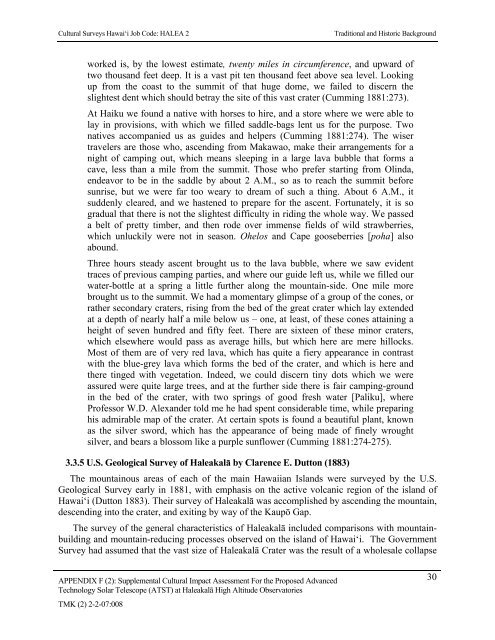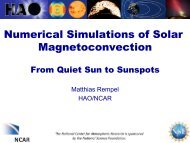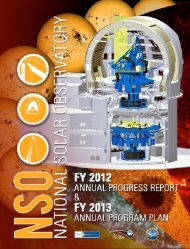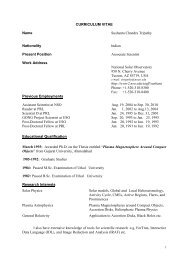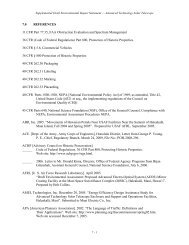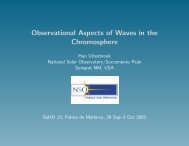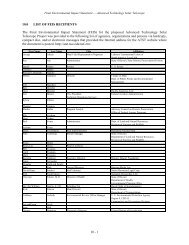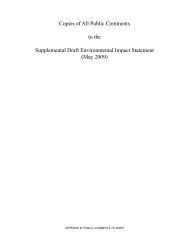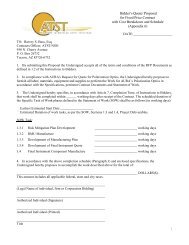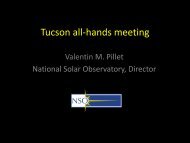F2 - ATST
F2 - ATST
F2 - ATST
Create successful ePaper yourself
Turn your PDF publications into a flip-book with our unique Google optimized e-Paper software.
Cultural Surveys Hawai‘i Job Code: HALEA 2Traditional and Historic Backgroundworked is, by the lowest estimate, twenty miles in circumference, and upward oftwo thousand feet deep. It is a vast pit ten thousand feet above sea level. Lookingup from the coast to the summit of that huge dome, we failed to discern theslightest dent which should betray the site of this vast crater (Cumming 1881:273).At Haiku we found a native with horses to hire, and a store where we were able tolay in provisions, with which we filled saddle-bags lent us for the purpose. Twonatives accompanied us as guides and helpers (Cumming 1881:274). The wisertravelers are those who, ascending from Makawao, make their arrangements for anight of camping out, which means sleeping in a large lava bubble that forms acave, less than a mile from the summit. Those who prefer starting from Olinda,endeavor to be in the saddle by about 2 A.M., so as to reach the summit beforesunrise, but we were far too weary to dream of such a thing. About 6 A.M., itsuddenly cleared, and we hastened to prepare for the ascent. Fortunately, it is sogradual that there is not the slightest difficulty in riding the whole way. We passeda belt of pretty timber, and then rode over immense fields of wild strawberries,which unluckily were not in season. Ohelos and Cape gooseberries [poha] alsoabound.Three hours steady ascent brought us to the lava bubble, where we saw evidenttraces of previous camping parties, and where our guide left us, while we filled ourwater-bottle at a spring a little further along the mountain-side. One mile morebrought us to the summit. We had a momentary glimpse of a group of the cones, orrather secondary craters, rising from the bed of the great crater which lay extendedat a depth of nearly half a mile below us – one, at least, of these cones attaining aheight of seven hundred and fifty feet. There are sixteen of these minor craters,which elsewhere would pass as average hills, but which here are mere hillocks.Most of them are of very red lava, which has quite a fiery appearance in contrastwith the blue-grey lava which forms the bed of the crater, and which is here andthere tinged with vegetation. Indeed, we could discern tiny dots which we wereassured were quite large trees, and at the further side there is fair camping-groundin the bed of the crater, with two springs of good fresh water [Paliku], whereProfessor W.D. Alexander told me he had spent considerable time, while preparinghis admirable map of the crater. At certain spots is found a beautiful plant, knownas the silver sword, which has the appearance of being made of finely wroughtsilver, and bears a blossom like a purple sunflower (Cumming 1881:274-275).3.3.5 U.S. Geological Survey of Haleakalā by Clarence E. Dutton (1883)The mountainous areas of each of the main Hawaiian Islands were surveyed by the U.S.Geological Survey early in 1881, with emphasis on the active volcanic region of the island ofHawai‘i (Dutton 1883). Their survey of Haleakalā was accomplished by ascending the mountain,descending into the crater, and exiting by way of the Kaupō Gap.The survey of the general characteristics of Haleakalā included comparisons with mountainbuildingand mountain-reducing processes observed on the island of Hawai‘i. The GovernmentSurvey had assumed that the vast size of Haleakalā Crater was the result of a wholesale collapseAPPENDIX F (2): Supplemental Cultural Impact Assessment For the Proposed Advanced 30Technology Solar Telescope (<strong>ATST</strong>) at Haleakalā High Altitude ObservatoriesTMK (2) 2-2-07:008


